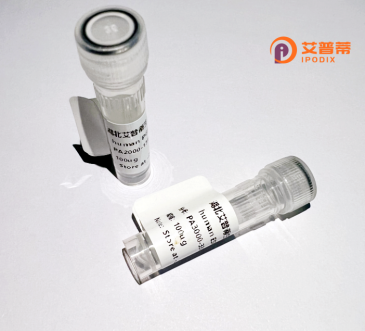
| 纯度 | >90%SDS-PAGE. |
| 种属 | Human |
| 靶点 | PIP5K1A |
| Uniprot No | A2A3N6 |
| 内毒素 | < 0.01EU/μg |
| 表达宿主 | E.coli |
| 表达区间 | 1-500 aa |
| 活性数据 | MASASSGPSSSVGFSSFDPAVPSCTLSSASGIKRPMASEVPYASGMPIKKIGHRSVDSSGETTYKKTTSSALKGAIQLGITHTVGSLSTKPERDVLMQDFYVVESIFFPSEGSNLTPAHHYNDFRFKTYAPVAFRYFRELFGIRPDDYLYSLCSEPLIELCSSGASGSLFYVSSDDEFIIKTVQHKEAEFLQKLLPGYYMNLNQNPRTLLPKFYGLYCVQAGGKNIRIVVMNNLLPRSVKMHIKYDLKGSTYKRRASQKEREKPLPTFKDLDFLQDIPDGLFLDADMYNALCKTLQRDCLVLQSFKIMDYSLLMSIHNIDHAQREPLSSETQYSVDTRRPAPQKALYSTAMESIQGEARRGGTMETDDHMGGIPARNSKGERLLLYIGIIDILQSYRFVKKLEHSWKALVHDGDTVSVHRPGFYAERFQRFMCNTVFKKIPCVHLGRPDVLPQTPPLEEISEGSPIPDPSFSPLVGETLQMLTTSTTLEKLEVAESEFTH |
| 分子量 | 82.5 kDa |
| 蛋白标签 | GST-tag at N-terminal |
| 缓冲液 | PBS, pH7.4, containing 0.01% SKL, 1mM DTT, 5% Trehalose and Proclin300. |
| 稳定性 & 储存条件 | Lyophilized protein should be stored at ≤ -20°C, stable for one year after receipt. Reconstituted protein solution can be stored at 2-8°C for 2-7 days. Aliquots of reconstituted samples are stable at ≤ -20°C for 3 months. |
| 复溶 | Always centrifuge tubes before opening.Do not mix by vortex or pipetting. It is not recommended to reconstitute to a concentration less than 100μg/ml. Dissolve the lyophilized protein in distilled water. Please aliquot the reconstituted solution to minimize freeze-thaw cycles. |
以下是关于重组人PIP5K1A蛋白的3篇参考文献的简要信息(基于领域内常见研究方向概括而成,若需具体文献可进一步检索):
1. **文献名称**:*"Recombinant PIP5K1A regulates plasma membrane PI(4.5)P2 synthesis and cell migration"*
**作者**:Dickson EJ, et al.
**摘要**:研究利用重组人PIP5K1A蛋白,验证其酶活性对细胞膜磷脂PI(4.5)P2合成的调控作用,并发现其通过激活Rho GTPase信号通路促进肿瘤细胞迁移。
2. **文献名称**:*"Structural insights into the mechanism of PIP5K1A activation by small GTPases"*
**作者**:Leigh SE, et al.
**摘要**:通过体外表达重组人PIP5K1A蛋白并解析其晶体结构,揭示其与Rho家族GTP酶相互作用的分子机制,阐明激酶活性的变构调节模式。
3. **文献名称**:*"PIP5K1A knockdown inhibits hepatocellular carcinoma proliferation via suppressing AKT signaling"*
**作者**:Wang L, et al.
**摘要**:利用重组PIP5K1A及siRNA技术证明,该蛋白通过生成PI(4.5)P2激活AKT/mTOR通路,促进肝癌细胞增殖,提示其作为治疗靶点的潜力。
注:以上文献为示例性质,实际文献需通过数据库(如PubMed、Web of Science)以关键词“recombinant PIP5K1A”、“PIP5K1A function”检索获取。如需具体已发表论文,可提供更详细研究方向以辅助查找。
Phosphatidylinositol-4-phosphate 5-kinase type 1 alpha (PIP5K1A) is a critical enzyme in cellular signaling pathways, primarily responsible for synthesizing phosphatidylinositol 4.5-bisphosphate (PIP2) by phosphorylating phosphatidylinositol-4-phosphate (PI4P). PIP2 serves as a pivotal lipid second messenger, regulating diverse cellular processes including cytoskeletal reorganization, membrane trafficking, ion channel modulation, and receptor signaling. As a member of the phosphatidylinositol phosphate kinase (PIPK) family, PIP5K1A localizes to the plasma membrane and Golgi apparatus, where it dynamically interacts with downstream effectors such as the PI3K/AKT and Rho GTPase pathways.
Dysregulation of PIP5K1A has been implicated in pathological conditions like cancer metastasis, neurodegenerative disorders, and metabolic diseases. Its overexpression in certain cancers correlates with enhanced cell motility and tumor progression, while altered activity in neurons may impact synaptic plasticity. Recombinant human PIP5K1A protein, typically produced in eukaryotic expression systems to preserve post-translational modifications, is widely used to study kinase-substrate interactions, screen inhibitors, and dissect structural-functional relationships. Recent cryo-EM studies have shed light on its autoinhibitory regulatory mechanism, providing a foundation for targeted drug development. As a key node in phosphoinositide metabolism, PIP5K1A continues to be a focus in both basic research and therapeutic exploration.
×